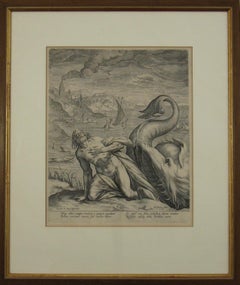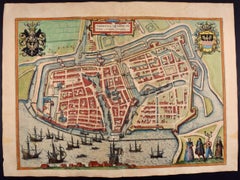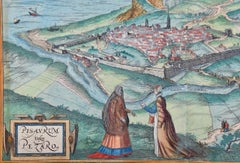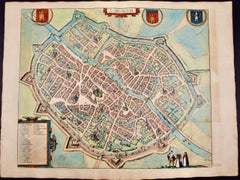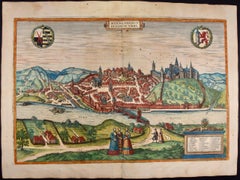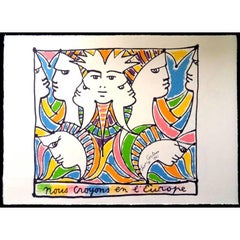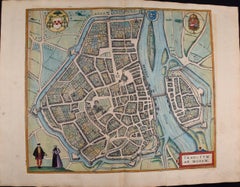16th Century More Prints
1
to
13
11
4
18
20
3
1
12
9
1
1
1
Overall Height
to
Overall Width
to
8
1
1
1
1
1
215
609
6,185
3,674
81
153
286
543
555
731
955
1,015
628
435
140
8
1
1
1
1
12
10
2
1
1
Period: 16th Century
Johannes Sadeler I (Flemish 1550-1600) – Engraving 1582 - Jonah and the Whale II
Located in Meinisberg, CH
Johannes Sadeler I
(Flemish, ∗ 1550 in Brussels, Belgium – † 1600 Venice, Italy)
Jonah Spat Up by the Whale (Sheet II)
Engraved by Sadeler after an image created by Theodor Bernard...
Category
Renaissance 16th Century More Prints
Materials
Laid Paper, Engraving
The Chess Game Texture Print By Renowned Italian Artist Francesco Beda
Located in LOS ANGELES, CA
**ANNUAL SUPER SALE UNTIL APRIL 15TH ONLY**
*This Price Won't Be Repeated Again This Year-Take Advantage Of It*
RESTORED, numbered and RARE Vintage Textured Print Aft...
Category
Expressionist 16th Century More Prints
Materials
Handmade Paper
View of Emden, Germany: A 16th Century Hand-colored Map by Braun & Hogenberg
Located in Alamo, CA
This is a 16th century original hand-colored copperplate engraved map of a bird's-eye View of Embden, Germany entitled " Emuda, vulgo Embden vrbs Frisia orientalis primaria" by Georg Braun & Franz Hogenberg, in volume II of their famous city atlas "Civitates Orbis Terrarum", published in Cologne, Germany in 1575.
This is a beautifully colored and detailed map of Emden, a seaport in northwestern Germany, along the Ems River and perhaps portions of over Dollart Bay, near the border with the Netherland. The map depicts a bird's-eye view of the city from the southwest, as well as a view of the harbor and an extensive system of canals. Numerous ships of various sizes, as well as two rowboats containing numerous occupants are seen in the main waterway in the foreground and additional boats line two canals in the center of the city. Two men and two women are shown on a hill in the foreground on the right, dressed in the 16th century style of nobility. Two ornate crests are included in each corner. A title strap-work cartouche is in the upper center with the title in Latin. The crest on the right including Engelke up de Muer (The Little Angel on the Wall) was granted by Emperor Maximilian I in 1495.
This is an English translation of an excerpt of Braun's description of Embden: "In Emden, the capital of East Frisia, rich merchants live in very fine houses. The city has a broad and well-situated harbour, which in my opinion is unique in Holland. Frisia and the whole of the Netherlands, for the ships can anchor here right under the city walls. They have also extended the harbour as far as the New Town, so that up to 400 ships can now find shelter here when the sea is rough."
The emphasis on the harbor and waterways within the city highlights the importance of Emden's place as a seaport at this time. Embden developed from a Dutch/Flemish trading settlement in the 7th-8th centuries into a city as late as late 14th century. In 1494 it was granted staple rights, and in 1536 the harbour was extended. In the mid-16th century Emden's port was thought to have the most ships in Europe. Its population then was about 5,000, rising to 15,000 by the end of the 16th century. The Ems River flowed directly under the city walls, but its course was changed in the 17th century by the construction of a canal. Emden has canals within its city limits, a typical feature of Dutch towns, which also enabled the extension of the harbor. In 1744 Emden was annexed by Prussia and is now part of Germany. It was captured by French forces in 1757 during the Seven Years' War, but recaptured by Anglo-German forces in 1758. During the Napoleonic French era, Emden and the surrounding lands of East Frisia were part of the short-lived Kingdom of Holland.
References:Van der Krogt 4, 1230, State 2; Taschen, Braun and Hogenberg...
Category
Old Masters 16th Century More Prints
Materials
Engraving
View of Pisaro, Italy: A 16th Century Hand-colored Map by Braun & Hogenberg
Located in Alamo, CA
This is a 16th century original hand-colored copperplate engraved map of View of Pezaro (Pisaro), Italy entitled "Pisaurum vulgo Pezaro" by Georg Braun & Franz Hogenberg, from their famous city atlas "Civitates Orbis Terrarum", published in Augsberg, Germany in 1575.
The map depicts a view of Pesaro, Italy from the west looking over the town to the Adriatic Sea. The River Foglia flows into the Adriatic in the foreground. The only identifiable building is the cathedral of San Domenico, which rises above the other roofs with its tall spire. Two women, dressed in styles of the 16th century are in conversation on a hill in the foreground on the left. Pesaro is in the province of Pesaro and Urbino and lies on the Adriatic and east of Florence. The city, which was founded by the Etruscans and named Pisaurum by the Romans, belonged from AD 754 onwards to the Papal States, and after 1285 was controlled by the princely families of Malatesta, Sforza and della Rovere. Today it is the capital of the province of Pesaro and Urbino and has a population of about 92,000. Pesaro's most famous resident, composer Gioacchino Rossini, was born here in 1792.
The following is an English translation of an excerpt from Braun's description of the city: "We believe that the astonishingly short life of the inhabitants of Pesaro comes not only from the insalubrious air, but also from the great quantity of delectable and delicious fruits which they consume to excess. For this causes the production in their bodies of evil humours, which then lead to incurably fatal diseases. The area around the city is most charming and well planted with vineyards, fig trees, olive trees and other fruit-bearing trees."
References: Van der Krogt 4, 3369, state 1; Taschen, Braun and Hogenberg...
Category
Old Masters 16th Century More Prints
Materials
Engraving
Tournai (Tournay), Belgium: A 16th Century Hand-colored Map by Braun & Hogenberg
Located in Alamo, CA
This is a 16th century original hand-colored copperplate engraved map of Tournai, Belgium, entitled "Tornacum" by Georg Braun & Franz Hogenberg, in volume IV of their famous city atlas "Civitates Orbis Terrarum", published in Cologne or Augsberg, Germany in 1575. The map provides a bird's-eye view of the walled city of Tournai, the second oldest city in Belgium. It lies approximately one hour by car southwest of Brussels or from Ghent. The names of thirty of its streets, prominent buildings, churches and squares are listed in a key within a strap-work cartouche in the lower left. These locations are numbered in the key corresponding to their locations on the map.
This colorful map of Tournai (Tornacum or Tournay as it was called in the 16th century) includes the title in Latin in a cartouche in the upper center. Three crests are present across the upper map. A man and two woman are standing on a hill in the foreground in the lower right dressed in the style of 16th century upper class residents of the town.
This is an English translation of an excerpt of Braun's description of Tornai: “Tornacum or Turnacum is a city in Gallia Belgica, situated on the Schelde in the territory of the Nervii, called Tournai by its French inhabitants, but Dorneck by the Germans. Tournai has always been a large and powerful city, with an abundance of goods and commercial activities and wonderfully resourceful craftsmen, who invent new articles every day, and although some of these go out of use they constantly conceive of other new things, both useful and delightful, so that they have at all times something that provides work and a means of livelihood for the poor."
ReferencesVan der Krogt 4, 4435, State 1; Taschen, Braun and Hogenberg...
Category
Old Masters 16th Century More Prints
Materials
Engraving
View of Meissen, Germany: A 16th Century Hand-colored Map by Braun & Hogenberg
Located in Alamo, CA
This is a 16th century original hand-colored copperplate engraved map of View of View of Meissen, Germany entitled "Misena Hermun Duvorum Urbs" by Georg Braun & Franz Hogenberg, from their famous city atlas "Civitates Orbis Terrarum", published in Cologne, Germany in 1575.
The map depicts a side view and bird's-eye view, looking across the Elbe River (labelled Albis Fluvius on the map; White River in Latin) from the northeast. In the foreground are three women in conversation on a hill above the city, along with a man and a woman in conversation by a road, all dressed in contemporary costumes of the upper class. A coat-of-arms is present in each upper corner. A great castle sits atop a hill in the background on the left. Meissen grew up around Albrechtsburg castle, built by Emperor Henry I around AD 929, and was granted a municipal charter at the end of the 12th century. From 1471 onwards, the castle complex was reconstructed as the residence of the Saxon electors on the northeast corner of the Domberg (Cathedral Hill). Meissen cathedral is a Gothic hall church begun c. 1270; in 1413 a bolt of lightning destroyed its west towers, which were replaced only in the 20th century. Meissen lies to the northwest of Dresden, Germany in Saxony. Meissen is famous for its Meissen porcelain and the Albrechtsburg castle
The following is an English translation of an excerpt from Braun's description of the city: "This city is surrounded by very many rivers, to the east flows the Elbe, to the south the Triebisch, to the west are the mountains, to the north the Meisse, after which the city is said to be named. The city is well-situated in its surroundings, the navigable rivers, the mountains and the healthy air. Around the city there is a good land to grow grain, fertile vineyards on the hillsides and without doubt the mountains are not without ore, for one mile away, up the Elbe, is Scharfenberg, where silver and lead ore are mined.."
References: Van der Krogt 4, 2684; Taschen, Braun and Hogenberg...
Category
Old Masters 16th Century More Prints
Materials
Engraving
View of Seravalle, Italy: A 16th Century Hand-colored Map by Braun & Hogenberg
Located in Alamo, CA
This is an original 16th century copperplate originally hand-colored engraved map of View of Seravalle, Italy entitled "Seravallum Celeberrimum Marchiae Tarvisiniae in Agro Foro Juliensi Opp. - Seravalli, quam vides, Spectator, iconem, operi huic nostro suis sumptib. . . ." by Georg Braun & Franz Hogenberg, from their famous city atlas "Civitates Orbis Terrarum", published in Augsberg, Germany in 1575.
The map depicts a view of Seravalle, now Vittorio Veneto, in San Marino, Italy, north of Venice, in a topographically accurate bird's-eye view from the south. A water-filled moat is seen to the south of the city walls and farmland to the east. Two men are depicted standing on a hill in the lower right in conversation next to grain sacks and a grazing horse, while a younger man behind them to the right herds a mule carrying presumably pigs. A very colorful and ornate title cartouche is in the upper center and coat-of-arms are in the right and left upper corners. Serravalle lies in an idyllic setting in the foothills and surrounded by orchards. St Mary's Cathedral with its tall bell tower is prominent in the center of the town. The marketplace and town hall with a bell tower in the square are depicted. Houses and shops are around the main square. Serravalle's importance as an agricultural centre is emphasized by the figures in the foreground. In 1337 Serravalle was conquered by the Republic of Venice. In 1866 the town was united with neighbouring Ceneda to form the town of Vittorio Veneto.
The following is an English translation of an excerpt from the French description of the city on the back of the map: "Serravalle, a market town renowned for cloth, wine and grain, is in such a beautiful situation that the number of its inhabitants, attracted by the loveliness of the place, has grown so much at times that the wall encircling it has had to be enlarged for the third time. The city with the surrounding town once belonged to the Church in Ceneda as an imperial fief. It subsequently became the seat of the Da Camino family (a princely house that at that time was one of the five most noble in all Italy). Now the city is under the sway of the Venetians but is prudently governed by them. For they send only one city councillor with instructions to ensure that justice prevails and to collect duties. In all else, power lies in the hands of the noble families."
This is a translation of the Latin in the title cartouche on the front: "The picture of the town of Serravalle, which you see, viewer, has been contributed to our work entirely at his own expense by Minutius, son of Hieronymus Minutius, a noble gentleman and one renowned for the far-reaching competence of his jurisdiction. We saw him sojourning in Cologne, where he was on business for Gregory XIII; while our good wishes accompany him, we should also like to accompany him on his way with this remembrance, even though it might be against his will, so that even those who have not seen him may learn of his excellence. However, those who do not yet know him will also see his excellence if God the Almighthy does not summon erring souls too soon back to the eternal seat of the Blessed."
References: Van der Krogt 4, 4728, State 1; Taschen, Braun and Hogenberg, p.331; Fauser, #14960
This striking hand-colored city view is printed on laid, chain-linked paper with wide margins. The sheet measures 16" high by 21" wide. There is a central vertical fold as issued and French text on the verso, with Latin on the front. There is some discoloration in the upper and right margins which may represent some watercolor paint from the time of the original hand-coloring of the map. There is a small hole to the right of the upper portion of the vertical fold, which is only visible when held up to light and an area of reinforcement on the verso of the lower vertical fold. The map is otherwise in very good to excellent condition.
Braun and Hogenberg's 'The Civitates Orbis Terrarum' was the second atlas of maps ever published and the first atlas of cities and towns of the world. It is one of the most important books published in the 16th century. Most of the maps in the atlas were engraved by Franz Hogenberg and the text, with its descriptions of the history and additional factual information of the cities, was written by a team of writers and edited by Georg Braun. The work contained 546 bird-eye views and map views of cities and towns from all over the world. It gave graphic representation of the main features of the illustrated cities and towns, including the buildings and streets. Although the ordinary buildings are stylized, the principal buildings are reproduced from actual drawings created on location. The principal landmarks and streets can still be recognized today. In addition, the maps often include the heraldic arms of the city, the nature of the surrounding countryside, the important rivers, streams and harbors, even depicting stone bridges, wooden pontoons, flat-bottomed ferries, ships and working boats, wharves and jetties, as well as land-based activities, including horsemen, pedestrians, wagons, coaches, and palanquins. Small vignettes are often included which illustrate the trade, occupations and habits of the local inhabitants, such as agriculture, paper-making and textiles, as well as local forms of punishment, such as gibbets, wheels, floggings etc. Large figures dressed in their local costume are often presented out of proportion in the foreground. The aim of the authors was to give as much information as possible in a pleasing visual form. They succeeded in creating maps that were both informative and decorative works of art. The atlas is a wonderful glimpse of life in medieval Europe.
Georg Braun (1541-1622) was German Catholic...
Category
Old Masters 16th Century More Prints
Materials
Engraving
Frankfort, Germany: A 16th Century Hand-colored Map by Braun & Hogenberg
Located in Alamo, CA
This is a 16th century original hand-colored copperplate engraved map of Frankfort, Germany entitled "Francenbergum, vel ut alij Francoburgum Hassiae Opp" by Georg Braun & Franz Hogenberg, from their famous city atlas "Civitates Orbis Terrarum", published in Cologne, Germany in 1595.
This is an English translation of an excerpt from the original text in the atlas:
"Frankenberg or, according to others, Francoburgum, a town in Hesse. Charlemagne vested the town of Frankenberg with many freedoms and privileges, which it still enjoys to this day, and on account of its valiant and victorious soldiers awarded a signet, upon which there formerly appeared a golden castle with a tower, together with the letter F and a golden crown.
Frankenberg, seen here from the northeast, lies on a hill above the River Eder. The hillside is covered with fields neatly separated by bushes and fences. Soaring above the town is the massive Liebfrauenkirche, which was modelled on St Elizabeth's church in Marburg. The New Town was founded in 1335 at the foot of the hill (right) and merged with the Old Town as late as 1556. Frankenberg was founded by Conrad of Thuringia in 1233/34 to prevent the archbishops of Mainz from expanding their sphere of influence...
Category
Old Masters 16th Century More Prints
Materials
Engraving
Christ on the Mount of Olives
By Albrecht Altdorfer
Located in New York, NY
A brilliant and early impression of this woodcut. Dark, well-inked, with strong contrasts and no sign of wear. From "The Fall and Salvation of Mankind Through the Life and Passion of Christ."
Category
Renaissance 16th Century More Prints
Materials
Woodcut
Canterbury: An Original 16th C. Framed Hand-colored Map by Braun & Hogenberg
Located in Alamo, CA
This is a framed 16th century map and city view of Canterbury, England entitled "Cantuarbury" by Braun & Hogenburg, from their famous landmark atlas of city views 'Civitates Orbis Terrarum' (Atlas of the Cities of the World), which was first published in Cologne, Germany in 1572. The map of Canterbury was first published in 1588. It depicts a detailed birdseye view of the completely walled and fortified city of Canterbury, with its cathedral the most prominent feature. The coat of arms of England, Canterbury, and the Archbishop of Canterbury are included.
This beautifully hand-colored map is presented in a gold-colored wood frame with a beaded inner trim and a paprika-colored mat that highlights details in the map. The frame measures 18.75" high by 22.25" wide by 0.875" deep. There is a central vertical fold, as issued. The map is in excellent condition.
Braun and Hogenberg's 'The Civitates Orbis Terrarum' was the second atlas of maps ever published and the first atlas of cities and towns of the world. It is one of the most important books published in the 16th century. Most of the maps in the atlas were engraved by Franz Hogenberg and the text, with its descriptions of the history and additional factual information of the cities, was written by a team of writers and edited by Georg Braun. The work contained 546 bird-eye views and map views of cities and towns from all over the world. It gave graphic representation of the main features of the illustrated cities and towns, including the buildings and streets. Although the ordinary buildings are stylized, the principal buildings are reproduced from actual drawings created on location. The principal landmarks and streets can still be recognized today. In addition, the maps often include the heraldic arms of the city, the nature of the surrounding countryside, the important rivers, streams and harbors, even depicting stone bridges, wooden pontoons, flat-bottomed ferries, ships and working boats, wharves and jetties, as well as land-based activities, including horsemen, pedestrians, wagons, coaches, and palanquins. Small vignettes are often included which illustrate the trade, occupations and habits of the local inhabitants, such as agriculture, paper-making and textiles, as well as local forms of punishment, such as gibbets, wheels, floggings etc. Large figures dressed in their local costume are often presented out of proportion in the foreground. The aim of the authors was to give as much information as possible in a pleasing visual form. They succeeded in creating maps that were both informative and decorative works of art. The atlas is a wonderful glimpse of life in medieval Europe.
Georg Braun (1541-1622) was German Catholic...
Category
Old Masters 16th Century More Prints
Materials
Engraving
Northern Italy: A 16th Century Hand-colored Map by Abraham Ortelius
Located in Alamo, CA
This is a framed 16th century hand-colored copperplate map of northern Italy entitled "Veronae Urbis Territorium a Bernardo Bragnolo Descriptium" by Abraham Ortelius from his atlas "Theatrum Orbis Terrarum", which was the first modern atlas of the world, with the first volume published in 1570. This map was part of a subsequent volume, published in Antwerp in 1584. It was based on an earlier map by Bernardo Brognoli.
This beautiful map of northern Italy is focussed on Verona and its environs, including Mantua. Lake Garda and the South Tyrol mountains are prominently depicted. There is a very large striking cartouche in the upper left and a decorative distance scale in the lower right.
This striking hand-colored map of northern Italy is presented in a gold-colored wood frame and an olive green-colored mat. It is glazed with UV conservation glass. All mounting materials used are archival. The frame measures 21.5" high by 28" wide by 0.75" deep. There is a central vertical fold, as issued, with slight separation of the lower portion of the fold. There are faint spots in the upper and right margins, but the map is otherwise in very good condition.
Abraham Ortelius (also known as Ortels, Orthellius, and Wortels) (1527-1598) was a Dutch cartographer, geographer, and cosmographer. He began his career as a map colorist. In 1547 he entered the Antwerp guild of St Luke as an "illuminator of maps". He had an affinity for business from an early age and most of his journeys before 1560, were for business. He was a dealer in antiques, coins, maps, and books.
His business income allowed him to acquire an extensive collection of medals, coins, and antiques, as well as a large library of books...
Category
Old Masters 16th Century More Prints
Materials
Engraving
Framed Rubbing of 1550 Brass Monument in Grote Kerk Church, Breda, Netherlands
Located in Alamo, CA
This is an engraving of a tomb monument rubbing that has been highlighted with gold color on a dark grey to black background. The rubbing is of a brass plaque on a stone slab. It has...
Category
Northern Renaissance 16th Century More Prints
Materials
Engraving
Famagvsta - Etching by George Braun - Late 16th Century
Located in Roma, IT
Famavgvsta is an etching realized by George Braun (1541 – 1622)
The state of preservation of the artwork is good.
Interesting B/W etching on coeval pap...
Category
16th Century More Prints
Materials
Etching
Brula - Etching by George Braun - Late 16th Century
Located in Roma, IT
Brvla is an original etching realized by George Braun (1541 – 1622)
The state of preservation of the artwork is good.
Interesting B/W etching on coeval...
Category
16th Century More Prints
Materials
Etching
Map of Ingolstadt - Etching by George Braun- Late 16th Century
Located in Roma, IT
This Ingolstadium is an original etching realized by George Braun and Franz Hogenberg.
The state of preservation of the artwork is good but aged and at the top on the right angle yo...
Category
16th Century More Prints
Materials
Etching
Map of Nemavsus - Etching by George Braun - Late 16th Century
Located in Roma, IT
This Map of Nemavsus is an original etching realized by George Braun (1541 – 1622)
The state of preservation of the artwork is good and aged on the edges of the sheet with a few sm...
Category
16th Century More Prints
Materials
Etching
Map of Broversavia - Etching by George Braun - Late 16th Century
Located in Roma, IT
This Map of Broversavia is an original etching realized by George Braun (1541 – 1622)
The state of preservation of the artwork is good and aged on the edges of the sheet with a few...
Category
16th Century More Prints
Materials
Etching
Map of Burdegalen - Original Etching by George Braun - 1575 ca.
Located in Roma, IT
This Burdegalen is an original etching realized in about 1575 by George Braun (1541 – 1622)
The state of preservation of the artwork is good and aged on the edges of the sheet with...
Category
16th Century More Prints
Materials
Etching
Ancient Map of Calaris - Etching by George Braun - Late 16th Century
Located in Roma, IT
Ancient Map of Calaris is an original etching belonging to the collection "Civitates Orbis Terrarurm" realized by Georg Braun and Frans Hogenberg.
The Civitates Orbis Terrarum (Atla...
Category
16th Century More Prints
Materials
Etching
Map of Goricum - Original Etching by George Braun - Late 16th Century
Located in Roma, IT
This Goricum is an original etching realized by George Braun (1541 – 1622)
The state of preservation of the artwork is good but aged with trace of foxing that doesn't affect the im...
Category
16th Century More Prints
Materials
Etching
Parnes - Original Etching by George Braun - Late 16th Century
Located in Roma, IT
Parnes is an original etching realized by George Braun (1541 – 1622)
The state of preservation of the artwork is good.
Interesting B/W etching on coeva...
Category
16th Century More Prints
Materials
Etching
Map of Safi - Original Etching by George Braun - Late 16th Century
Located in Roma, IT
This Safi is an original etching realized by George Braun (1541 – 1622)
The state of preservation of the artwork is good.
Interesting B/W etching on coeval paper, this artwork rep...
Category
16th Century More Prints
Materials
Etching
Map of Arras - Etching by George Braun - Late 16th Century
Located in Roma, IT
This Map of Arras is an original etching realized by George Braun (1541 – 1622)
The state of preservation of the artwork is good but aged with trace of foxing that doesn't affect t...
Category
16th Century More Prints
Materials
Etching
Jerusalem, Antique Map from "Civitates Orbis Terrarum" - 1572-1617
Located in Roma, IT
Braun G., Hogenberg F., Jerusalem, from the collection Civitates Orbis Terrarum, Cologne, T. Graminaeus, 1572-1617.
Image dimensions: cm 32.8 x 41; dimensions: cm 41 x 54; Passepart...
Category
16th Century More Prints
Materials
Etching
Related Items
Mick Jagger IV - Andy Warhol, Announcement card, Rolling Stones, Musician, Pop
Located in Knowle Lane, Cranleigh
Mick Jagger IV - After Andy Warhol. In this print, the portrait is mostly black and white, with gleaming hair and an orange overlay on one side of his face. Mick Jagger is an iconic ...
Category
Pop Art 16th Century More Prints
Materials
Lithograph
H 12.01 in W 8.67 in D 0.79 in
Jean Cocteau - Europe and the World - Lithograph
By Jean Cocteau
Located in Collonge Bellerive, Geneve, CH
Lithograph by Jean Cocteau
Title: Europe and the World
Signed in the plate
Dimensions: 33 x 46 cm
Edition: 200
Luxury print edition from the portfolio of Sciaky
1961
Category
Modern 16th Century More Prints
Materials
Lithograph
Foggy Night (the way home or a Stephen King setting)
By Carol Wax
Located in New Orleans, LA
This impression is #22
Carol Wax originally trained to be a classical musician at the Manhattan School of Music but fell in love with printmaking. Soon after she began engraving mez...
Category
American Modern 16th Century More Prints
Materials
Engraving, Mezzotint
India William Hodges 'The East End of the Fort of Mongheer' India Engraving
Located in Norfolk, GB
Aquatint with soft ground etching from the seminal publication, Selected Views in India, drawn on the Spot, in the Years 1780, 1781, 1782 and 1783, and Executed in Aquatint in 1786 -...
Category
Other Art Style 16th Century More Prints
Materials
Engraving
Love Catcher - Red
Located in Washington, DC
Artist: Mr. Brainwash
Title: Love Catcher - Red
Medium: Screenprint on Archival paper
Date: 2023
Edition: 75
Frame Size: 28" x 28 1/2"
Sheet Size: 22" x 22"
Signature: Hand signed wi...
Category
Contemporary 16th Century More Prints
Materials
Paper, Screen
India William Hodges 'A View of the Ravines at Etana' Early India Engraving
Located in Norfolk, GB
William Hodges
Plate 27 'A View of the Ravines at Etawa'
Published 20th May 1787 by J Wells, 22 Charing Cross.
Page size, 16.5” x 22.5”, image 11.25 x 18”
Aquatint with soft gro...
Category
Other Art Style 16th Century More Prints
Materials
Engraving
Pablo Picasso (after) Helene Chez Archimede - Wood Engraving
Located in Collonge Bellerive, Geneve, CH
Pablo Picasso (after)
Helene Chez Archimede
Medium: engraved on wood by Georges Aubert
Dimensions: 44 x 33 cm
Portfolio: Helen Chez Archimede
Year: 1955
Edition: 240 (Here it is on...
Category
Modern 16th Century More Prints
Materials
Wood, Archival Paper, Engraving
H 17.33 in W 13 in D 0.04 in
Domergue - Almost Dressed - Original Lithograph
Located in Collonge Bellerive, Geneve, CH
Original Lithograph by Jean-Gabriel Domergue
Title: Almost Dressed
Signed in the plate
Dimensions: 40 x 31 cm
1956
Edition of 197
This artwork is part of the famous portfolio "La Par...
Category
Impressionist 16th Century More Prints
Materials
Lithograph
H 15.75 in W 12.21 in D 0.04 in
Lafitte's Blacksmith House (a bar named for a pirate on Bourbon St, New Orleans)
Located in New Orleans, LA
Lafitte's Blacksmith Shop is a New Orleans landmark at 941 Bourbon St. Like most New Orleans legends, history of Lafitte's Blacksmith Shop is a gumbo of tru...
Category
Contemporary 16th Century More Prints
Materials
Mezzotint, Aquatint
Overlooking Wadi, Saudi Arabia - Signed Lithograph, Royal Art, Mountains, Asir
Located in Knowle Lane, Cranleigh
Overlooking Wadi, Asir Province, Kingdom Of Saudi Arabia by His Majesty King Charles III, (created when he was HRH The Prince of Wales) - ...
Category
Academic 16th Century More Prints
Materials
Lithograph
H 23.23 in W 20.87 in D 1.19 in
“Equal Rights, Flower of Democracy” Chuck Sperry Screenprint
By Chuck Sperry
Located in Draper, UT
I am very happy to reveal my poster to raise awareness for the Equal Rights Amendment. This issue means so much to me. Equality is the central issue of our day.
“Equality is the flower of democracy. Passing the Equal Rights Amendment — at long last — will be the path to gender equality for our American democracy. I am grateful to be called upon to include my voice in the collective call to bring about gender equality by amending the Constitution with passage of the ERA, and I was quick to reach out to fellow artists to join the call to action.” — Chuck Sperry, artist statement for Artists 4 ERA
VoteEqualityUS is a nonpartisan grassroots effort promoting equal rights for all Americans, working to ensure the addition of the fully-ratified 28th Amendment (Equal Rights) to the United States Constitution...
Category
Contemporary 16th Century More Prints
Materials
Screen
Burn Baby Burn Shepard Fairey Letter Press Print Obey Publishing Chop Urban Art
Located in Draper, UT
Burn Baby Burn, inspired by the aesthetics of “live fast – die young” rock ’n’ roll, is a critique of some harmful habits we are addicted to. Not just the harmful effects of burning ...
Category
Street Art 16th Century More Prints
Materials
Screen
Previously Available Items
Nevers & Autun France: 16th Century Hand-colored Map by Braun & Hogenberg
Located in Alamo, CA
This is a pair of 16th century original hand-colored copperplate engraved maps on one sheet by Georg Braun & Franz Hogenberg, in volume III of their famous city atlas "Civitates Orbis Terrarum", published in Cologne, Germany in 1575. The map on the left, a bird's-eye View of Autun, France, is entitled "Augustodunum, Flavia Heduorum, que et Hedua, ab Hedorum augurio ...." and the map on the right, a bird's-eye view of Nevers, France is entitled: Noviodunum, Aeduorum Oppidum apud Casearem lib. de bello Gallico VII Vigenerus, Nevers indigetat.
The colorful map of Autun on the left includes a title cartouche in the upper left with Latin text. A man and a woman are standing on a hill in the foreground dressed in the style of 16th century upper class residents of the town. A title cartouche containing Latin is [resent in the lower right corner of the map of Nevers, along with a crest in the right upper corner.
The bird's-eye view of Autun from the west depicts a spacious tract of land bordered by city walls on the far side of the small Arroux River, shown in the foreground. The oval district of Marchaux is in the center of town, with two Roman gateways. Autun was founded by Emperor Augustus following the suppression of the Gauls in 10 BC and called Augustodunum after him. The Roman Temple of Janus is in the lower right. The cathedral of Saint-Lazare is in the upper right. During the Middle Ages the relics of St Lazarus...
Category
Old Masters 16th Century More Prints
Materials
Engraving
Maastricht, Netherlands: A 16th Century Hand-colored Map by Braun & Hogenberg
Located in Alamo, CA
This is a 16th century original hand-colored copperplate engraved map of Maastricht, Netherlands entitled "Maestricht, Traiectum Ad Mosam" (Translation of Latin: I crossed the bridge...
Category
Old Masters 16th Century More Prints
Materials
Engraving
Map of Marseilles, France: A 16th Century Hand-colored Map by Braun & Hogenberg
Located in Alamo, CA
This is a 16th century original hand-colored copperplate engraved map of Marseilles, France entitled "Marseille" by Georg Braun & Franz Hogenberg, fro...
Category
Old Masters 16th Century More Prints
Materials
Engraving
The Last Judgment
By Daniel Hopfer
Located in New York, NY
A brilliant, richly-inked impression of this large, scarce, early etching with very strong contrasts and no sign of wear. First state (of 2). There have only been 6 other early, firs...
Category
Italian School 16th Century More Prints
Materials
Etching
Solomon's Idolatry
By Lucas van Leyden
Located in New York, NY
An excellent boldly-inked impression of this scarce engraving by van Leyden. Trimmed on the plate mark.
Category
Dutch School 16th Century More Prints
Materials
Engraving
First Map of Cambridge in 1575, by Georg Braun and Franz Hogenberg
Located in London, GB
To see our other views of Oxford and Cambridge, scroll down to "More from this Seller" and below it click on "See all from this Seller" - or send us a message if you cannot find the view you want.
Georg Braun (German, 1541-1622) and Frans Hogenberg (German, Flemish 1535-1590)
Map of Cambridge (1575)
33 x 44 cm
Engraving with later hand colouring
This early map of Cambridge was first published in the second book of the six volume 'Civitates Orbis Terrarum' devised by German topo-geographer Georg Braun and drawn up by Flemish German engraver Franz Hogenberg...
Category
Realist 16th Century More Prints
Materials
Engraving
Americae Pars Magis Cognita.
Located in New York, NY
Late 16th-century map by Theodor de Bry. Engraved, circa 1592. The image size is 14 1/4 x 17 1/4" (36.2 x 44 cm) plus margins.
This highly decorative map focuses on the Spanish ...
Category
Other Art Style 16th Century More Prints
Materials
Engraving
Recently Viewed
View AllMore Ways To Browse
Andalusia Poster
Day Tripper
Locomotive Lithograph
Metropolitan Museum Of Art Tiffany Stained Glass
Bermuda Travel Poster
Vintage Ski Posters Savoie
Ancient Hebrew Texts
André Masson On Sale
Retro Travel Poster Edinburgh
Malaya Vintage Poster
Malaya Poster
Le Mont St Michel
Rolling Stones Tattoo You
Travel Poster Bermuda
Vintage Rallye Posters
Ww2 Propaganda Posters
Vintage Ww2 Propaganda Posters
Laure Prouvost
